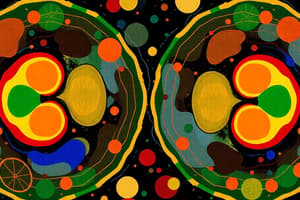Podcast
Questions and Answers
During which phase of the cell cycle does DNA replication occur?
During which phase of the cell cycle does DNA replication occur?
- G2 phase
- M phase
- S phase (correct)
- G1 phase
Which process ensures chromosome number remains consistent across generations in sexually reproducing organisms?
Which process ensures chromosome number remains consistent across generations in sexually reproducing organisms?
- Binary fission
- Meiosis (correct)
- Mitosis
- Asexual Reproduction
What is the primary function of the mitotic phase (M phase) in the cell cycle?
What is the primary function of the mitotic phase (M phase) in the cell cycle?
- Separation of sister chromatids and cell division (correct)
- DNA replication
- Synthesis of proteins and organelles
- Cell growth and preparation for division
What is the significance of 'checkpoints' in cell cycle regulation?
What is the significance of 'checkpoints' in cell cycle regulation?
How do external influences, such as hormones, affect the cell cycle?
How do external influences, such as hormones, affect the cell cycle?
Which of the following best describes the role of tRNA in protein synthesis?
Which of the following best describes the role of tRNA in protein synthesis?
What is the role of DNA ligase in DNA replication?
What is the role of DNA ligase in DNA replication?
During what stage of meiosis does crossing over typically occur?
During what stage of meiosis does crossing over typically occur?
How does a somatic cell nuclear transfer (SCNT) result in a clone?
How does a somatic cell nuclear transfer (SCNT) result in a clone?
HCG (Human Chorionic Gonadotropin) is commonly tested for in pregnancy tests. What produces this hormone?
HCG (Human Chorionic Gonadotropin) is commonly tested for in pregnancy tests. What produces this hormone?
Flashcards
Interphase
Interphase
The period of growth and normal function between cell divisions.
Mitotic phase
Mitotic phase
The cell cycle phase involving cell division, including mitosis or meiosis, resulting in two or more daughter cells.
DNA replication
DNA replication
The copying of DNA, creating an exact duplicate.
Gene
Gene
Signup and view all the flashcards
Chromosome
Chromosome
Signup and view all the flashcards
Codon
Codon
Signup and view all the flashcards
Transcription
Transcription
Signup and view all the flashcards
Translation
Translation
Signup and view all the flashcards
Transfer RNA (tRNA)
Transfer RNA (tRNA)
Signup and view all the flashcards
Ribosomes
Ribosomes
Signup and view all the flashcards
Study Notes
- Humans develop from a single fertilized egg into a complex organism of over 10 trillion cells in just 9 months.
- All cells come from previously existing cells.
- Before a cell divides, its genetic material is replicated completely and accurately.
- In multicellular organisms, cells differentiate during development.
- Cell division and differentiation is highly regulated.
Functions of cell division
- Unicellular organisms use cell division for reproduction.
- Multicellular organisms use cell division for development, growth, renewal, and repair.
Cell Cycle Phases
- Interphase and the mitotic phase are the two main phases.
Interphase
- Long growth period between cell divisions.
- Has G1, S, G2, and G0 phases.
G1 (First Gap)
- Primary growth period.
- Known as the "organelle factory."
- Protein and organelle synthesis occur; cytoplasm volume increases.
- Lasts 5-6 hours.
S (Synthesis)
- Replication occurs; DNA is duplicated.
- Three processes are essential for DNA function: replication, transcription, and translation.
- Lasts 10-12 hours.
G2 (Second Gap)
- Preparation for cell division; chromatin condenses into chromosomes.
- Known as "double-checking".
- DNA becomes 10,000 fold shorter.
- Lasts 4-6 hours.
G0
- Cells are in a non-dividing state.
- Can be permanent or temporary.
Mitotic (M) Phase
- Cell division occurs.
Mitosis/Meiosis
- Nuclear division where DNA is duplicated.
- Mitosis results in 2 diploid daughter cells.
- Meiosis results in 4 haploid cells.
PMAT
- Phases: prophase, metaphase, anaphase, telophase.
Cytokinesis
- Cytoplasm (cell) division occurs.
- In human cells, the complete cell cycle takes 18-24 hours.
- Cell replication isn't consistent.
- Internal surveillance and control mechanics regulate it.
- Checkpoints in G1, G2, and Mitosis need "go ahead" signals to prevent cancer cell formation.
- External influences can modify cell cycle
- Cyclin kinases regulate cell division.
Mitosis vs. Meiosis
- Mitosis generates diploid cells; meiosis generates haploid cells.
- Mitosis occurs in asexual reproduction; meiosis occurs in sexual reproduction.
- Two cell divisions occur in meiosis with Meiosis I and II.
- Mitosis results in identical cells; meiosis results in genetically different cells.
- In meiosis, crossover occurs.
Crossover
- It involves the exchange of parts of chromosomes.
- Synaptonemal complex: Holds homologous chromosomes together during crossing over.
- Chiasmata: Site of exchange.
- Recombinant chromosomes: Used in creating new DNA.
Human Life Cycle
- Haploid gametes (n=23) include sperm and ovum.
- After fertilization, diploid zygote (2n=46) is formed.
- Oogenesis = Ovum (mature egg) production.
- Oogonium is a female egg cell formation.
- Ootid is the egg cell from Meiosis II.
- Follias-Stimulating Hormone (FSH) periodically stimulates follicles to resume development.
- Usually one egg is released for fertilization monthly.
- Fertilization merges sperm and oocyte chromosomes in the oviduct.
- Zygote results from fusion of sperm and egg (46 chromosomes).
Early Embryonic Stage
- Gamete formation and fertilization occur.
- Sperm + egg = zygote.
- Cleavage divides regions of egg cytoplasm.
- Gastrulation specializes tissues and assigns tasks to cells.
- Organ formation sculpts specific organs and tissues.
- Growth and tissue specialization increases size and gradually assumes functions.
- Early cell division occurs 18-36 hours after fertilization; zygote divides into two cells.
- Cleavage is a series of cell divisions without growth (4 days after fertilization).
- The zygote receives nutrients and begins to grow in size and divides, increasing cell number.
- During differentiation, 16 cells specialize into forms and functions during morphogenesis.
- Cells alter shape, starting as a ball; beginning of form.
- Each new cell is referred to as a blastomere.
- Morula: 16-celled zygote; mulberry; in the uterus
Implantation
- Refers to the attachment of the fertilized egg to the uterus lining, which occurs approximately 6-7 days after conception.
- the blastocyst contacts the endometrium
- trophoblast cells attach to the endometrial epithelium.
- invasive trophoblast cells cross endometrial epithelium basement membrane and invade
Maternal Changes
- Human Chorionic Gonadotropin (HCG) is secreted by the placenta and peaks at week 8-9.
- Pregnancy tests detect HCG levels in blood or urine.
- Ectopic pregnancy is when implantation happens outside the uterus, in the uterine tubes.
- Gastrulation forms germ layers
- The three layers are: ectoderm, mesoderm, endoderm
Cell Differentiation
- Where a cell becomes different from its parent or sister cell
- Based on different gene expression
- Environmental factors influence cell differentiation
- All body cells have the same DNA, yet there are differences in shape and function
Differentiation Later in Development
- External substances harmful to fetuses: - Cigarette smoke retards growth - Alcohol results in fetal alcohol syndrome - Medication (Rx or OTC): low birth weight/ premature birth - Illegal drugs: preterm birth, cognitive and behavioral problems - Environmental chemicals: low birth weight, affects growth & development - Radiation: radon, X-rays = miscarriages, birth defects - Intrauterine infections: HIV, syphilis, rubella= birth defects
Reproductive cloning
- Copies entire organism.
Reproductive Cloning: Embryo splitting
- Requires undifferentiated cell as the starting point.
- Until 8-cell stage, wherein all 8 are still identical .
- Fertilized in vitro
- Cells separated/ implanted into a different surrogate mother = exact genetic copy
Reproductive Cloning: Somatic cell nuclear transfer
- Clone is obtained from parent( Somatic cell + egg (clone of the parent); yields a true clone of an adult organism (eg. Dolly the sheep, 1997, by Ian Wilmut)
- Somatic cell to be cloned inserted into an enucleated egg,.
- electrical current is used to fuse
- Fused cell is implanted and allowed to develop = clone
Therapeutic cloning
- Creating tissue/organs that can be used to treat specific diseases or conditions in human patients
Cancer cells
- Tumor=neoplasm (new growth) . - enlargement but stays well-contained
Benign tumor
- Begins when a person cell becomes genetically altered and begins to divide more frequently than normal.
Malignant tumor
- Invades normal tissue/ secondary tumors enter the blood or lymph - environmental (Carcinogens, viruses, bacterias, diet & lifestyle) or internal factors (immune system, protooncogenes).
Components of Molecular Biology
- Genes are segments of DNA that control the production of proteins, which determine an organism's traits.
- A chromosome is a threadlike structure containing DNA or genetic information within the cell's nucleus.
- "Chroma" - colored
- "Soma" - body
- Chromosomes ensure accurate DNA transfer during cell division.
- humans: 46 chromosome/23 pairs, first 22 pairs are Autosomes while the last 1 pair are Allosome
- Chromosome arms= P arm and Q arm; Centromere joins sister chromatids together; Telomere ends of arms
- Human: 23 pairs, Animals: 39 pairs, Plants: 12 pairs, Insects: 4 pairs
Central Dogma
- Describes the flow of genetic information: DNA to messenger RNA (mRNA) to protein sequences.
Nucleic Acids
- Store genetic information (DNA/RNA)
Nucleotides
- Building block of nucleic acids
- RNA and DNA have same polymers of long chain nucleic acids.
- nucleotide consists of: 1. 5-carbon sugar (pentose), 2. Phosphate group, and, 3. Nitrogenous base
Nitrogenous Bases
- Purines (double ringed): Guanine [G], Adenine [A]
- Pyrimidines (single ringed): Cytosine [C], Thymine [T], Uracil [U]
Nucleotide Sequence
- Order of nucleotide codes for polypeptide chain
Codon
- series of three nucleotides = amino acids
DNA
- DNA contains deoxyribose sugar
- It is double stranded
RNA
-
Has ribose sugar and is single stranded
-
DNA located in the nucleus but cytoplasm may also be located in mitochondria
-
RNA-mostly cytoplasm and also in the nucleus:
-
stores and carries out biological guidelines
-
DNA/RNA transfer blueprint guidelines
-
Primers of DNA polymerase build the bases;
-
Ligase breaks and seals DNA strand during Cell Replication
Process
- DNA Helicase: breaks hydrogen bonds/ nucleotides (DNA into two single strands)
- DNA Primase releases primers that pairs A binds only to T, and C only to G with DNA Polymerase which results in avoidance mistakes/
- enzyme DNA ligase seals strand breaks
- DNA polymerase + DNA ligase repair DNA from radiation/toxic chemicals
- Semiconservative Replication
Gene Mutation
- 3 billion nucleotides need to be assembled for DNA: assembled properly and rapidly/
- gene mutation results in substitution, deletion/Insertion
- DNA polymerase proofreads each nucleotide -Mismatch repair enzymes
Protein synthesis
- Involves Transcription and Translation:
Transcription and translations
- Anitbody protects against foreign elemens, enzyme catalyzes reactions, messenger transmits signals by transporting small molecules
Studying That Suits You
Use AI to generate personalized quizzes and flashcards to suit your learning preferences.
Related Documents
Description
Explore cell division, focusing on its functions in both unicellular and multicellular organisms. The lesson highlights the cell cycle phases, particularly interphase with its G1, S, and G2 phases, detailing the critical processes like DNA replication and protein synthesis. Understand how cells grow, replicate, and prepare for division.





